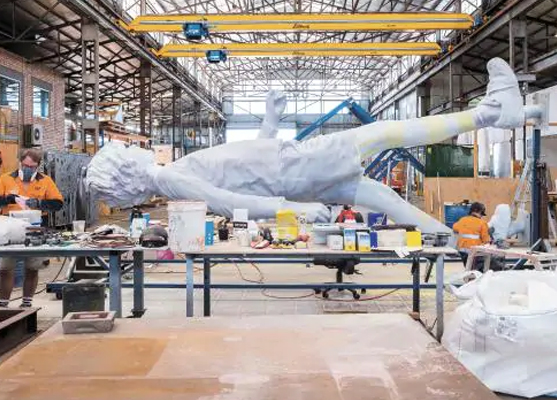Manufacturing is coming home
Brisbane-based art and architectural manufacturer UAP (Urban Art Projects) has re-shored much of its production to Australia, pulling it back from its China foundry, thanks to advanced manufacturing techniques, pioneering robotics and changed global trade conditions.
Co-founder and managing director Matthew Tobin says innovation and technology is allowing UAP to compete globally.
“Ten years ago we thought our workshop in Australia would be a prototype workshop and everything would be made in China,” he says. “A decade on, we know that is entirely inaccurate and our manufacturing will be made locally. To be viable and competitive as a manufacturer, especially as a custom manufacturer, it’s going to be cheaper to do it locally.”
Over the last two years, robotics and innovation have boosted the company’s ability to re-shore manufacturing from its Shanghai workshop to the suburbs of Brisbane. UAP is in the midst of a transformation: in 2017 it imported 32 per cent of all its works destined for Australian sites, compared with 8 per cent this year. UAP’s Queensland workshop has grown from 20 employees in 2017 to 57 this year. The number of Australia-based employees has risen from 82 to 125.
“Technology is making manufacturing cool again,” says Tobin, who runs one of the world’s biggest public art and architecture manufacturers.
When an artist dreams up the façade of a commercial building dotted with multicoloured stainless steel butterflies, UAP can make it real. When a public art commission demands a walking boy, mid-stride, six metres tall, UAP can make that too. Ditto a giant knitted octopus.
The company was founded in Brisbane in 1993 by Tobin and his brother Daniel. Just after its 25th anniversary last year, UAP bought New York’s Polich Tallix Fine Art Foundry, the company that makes the Oscar statues for the Academy Awards. It has worked with international artists Ai Weiwei and Idris Khan, and architects Zaha Hadid and Frank Gehry on creations big and small, but always unique.
A few years ago, the brothers decided that to stay competitive, they would have to embrace technology. Their costs in China were increasing and the Australian dollar was plummeting, changing their business environment. The team was creating the sculptural staircase of Sydney’s UTS Business School’s Dr Chau Chak Wing Building, designed by US star architect Gehry. (Australian-Chinese businessman and philanthropist Chau Chak Wing donated $20 million to the project, with an additional $5 million for Australia-China scholarships.)
Tobin says there was a gap between the innovation in the digital design and the reality of its manufacture, which required the 5000-year-old technique of panel-beating and thousands of man hours. “The staircase started us on this process where we realised we needed to use some layer of automation to make us competitive,” he says. “But because we make unique objects, we needed that automation to see.”
They teamed up with the Innovative Manufacturing Co-operative Research Centre, QUT and RMIT University to introduce advanced robotics and technology, aiming to create smart and seeing robots for a new age of manufacturing.

